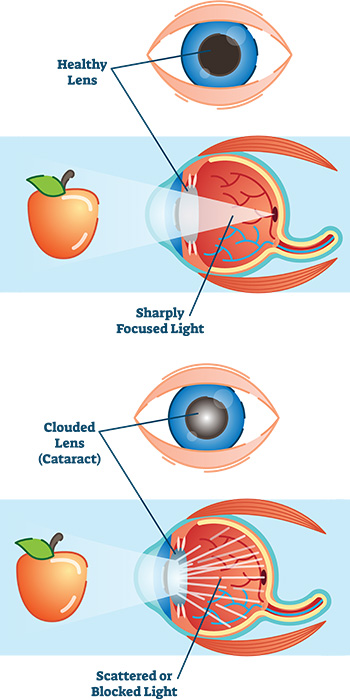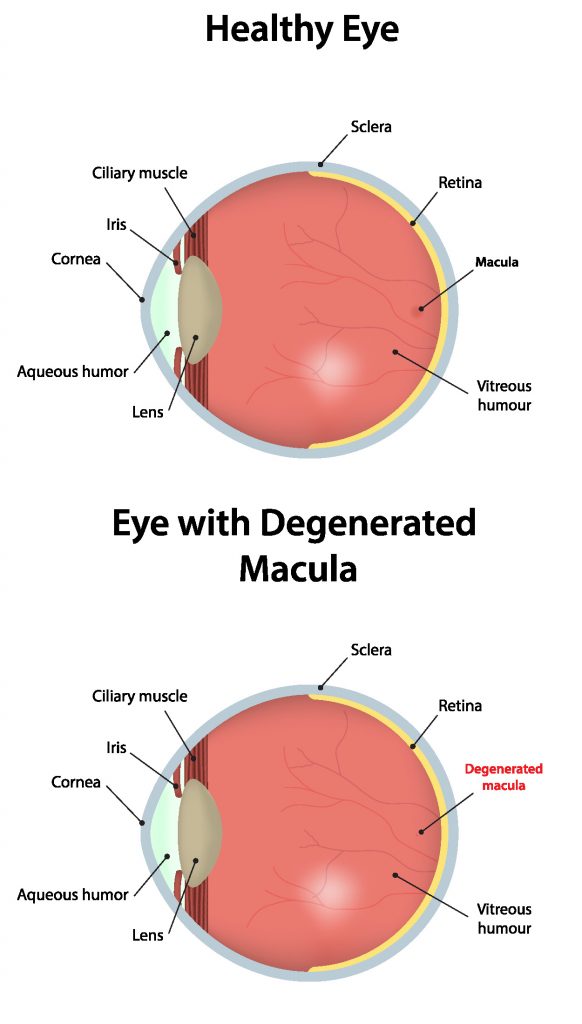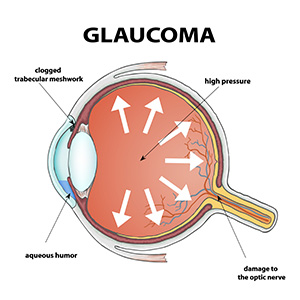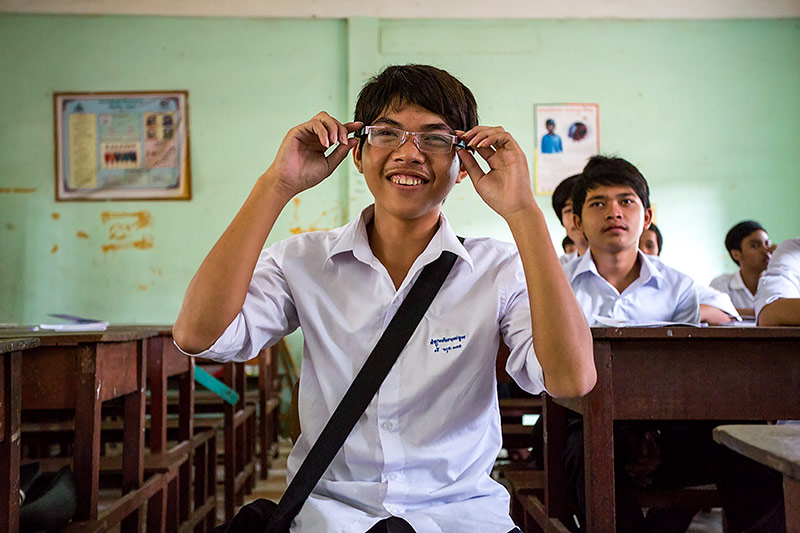Eye conditions or diseases like macular degeneration, glaucoma, and cataracts, can cause vision problems. Each of these diseases have varying symptoms that may not have early symptoms. They may be painless, and you may see no change in your vision until the disease has become quite advanced. Therefore, it is important to have regular eye exams, especially if you notice a difference in your vision.
Cataract

A cataract is a clouding of the natural lens in the eye and the leading cause of vision loss in adults over 55 years of age. Symptoms of cataracts include foggy or blurry vision, natural colours appear muted, difficulty reading and driving, decreased night vision and halos around lights.
Cataracts can happen in one or both eyes and is closely related to aging, but may be accelerated by diabetes or eye trauma. A cataract is NOT a “film” over the eyes and CANNOT be cured by drops, diet or laser.
Most cataracts develop slowly and may not disturb your eyesight early on. At first, stronger lighting and eyeglasses can help you deal with cataracts. But if impaired vision interferes with your usual activities, you might need cataract surgery. Fortunately, cataract surgery is generally a safe and effective procedure. More info
Diabetic Retinopathy
Diabetic retinopathy is one of the most common complications of diabetes. It can develop in people with both type 1 and type 2 diabetes, and usually affects both eyes. This disease is a leading cause of blindness. It is caused by changes in the blood vessels of the retina. In some people with diabetic retinopathy, retinal blood vessels may swell and leak fluid. In other people, abnormal new blood vessels grow on the surface of the retina. These changes may result in vision loss or blindness. If treated early these changes are reversible, however if left untreated, they may lead to permanent vision loss.
Age Related Macular Degeneration
Age related macular degeneration (AMD) is the leading cause of legal blindness among people over 50 in the Western world. It causes blurred or reduced central vision, and usually affects both eyes . The macula is the part of the retina responsible for clear central vision.

Dry AMD, the more common type, may first develop in one eye and then affect both eyes. It is characterised by a collection of yellow, fatty deposits in the macula.
Dry macular degeneration is a common eye disorder among people over 50. It causes blurred or reduced central vision, due to thinning of the macula (MAK-u-luh). The macula is the part of the retina responsible for clear vision in your direct line of sight.
Dry macular degeneration may first develop in one eye and then affect both. Over time your vision may worsen and affect your ability to do things such as read, drive and recognize faces. But this doesn’t mean you’ll lose all of your sight. Early detection and self-care measures may delay vision loss due to dry macular degeneration.
For more information about Age Related Macular Degeneration, click here.
Glaucoma

Glaucoma is a group of diseases associated with damage to the optic nerve, that connects your eye to your brain and transmits signals back and forth. This damage is often caused by an abnormally high pressure in your eye. Glaucoma is one of the leading causes of blindness for people over the age of 60.
For more information about Glaucoma, click here.
Kerataconus
Keratoconus is a progressive eye disease in which the normally round cornea thins and begins to bulge into a cone-like shape. This cone shape deflects light as it enters the eye on its way to the light-sensitive retina, causing distorted vision.
Keratoconus can occur in one or both eyes and often begins during a person’s teens or early 20s.
Allergy & Dry Eyes
Certain medical conditions can also cause dry eye. The most common symptoms include burning, a sandy, gritty feeling, redness and sometimes reflex tearing. While eye allergies can also cause redness and tearing, the main symptom is itching. Treatment is different for dry eye and ocular allergies.
For more info, click here.
Strabismus (wandering eye)
Strabismus, more commonly known as cross-eyed or wall-eyed, is a vision condition in which a person can not align both eyes simultaneously under normal conditions. One or both of the eyes may turn in, out, up or down.
Blepharitis
(Blef-uh-RYE-tis) is the inflammation of the eyelids, which usually involves the part of the eyelid where the eyelashes grow. Both eyelids are affected.
The inflammation commonly occurs when tiny oil glands located near the base of the eyelashes become clogged. This leads to irritated and red eyes. Several diseases and conditions can cause blepharitis.
Blepharitis is often a chronic condition that is difficult to treat and can be uncomfortable and may be unsightly. But it usually doesn’t cause permanent damage to your eyesight, and it’s not contagious.
Paediatric Ophthalmology
This is the study of the development of the visual system and the various diseases that disrupt visual development in children. Pediatric ophthalmologists also have expertise in managing the various ocular diseases that affect children. They are qualified to perform complex eye surgery as well as to manage children’s eye problems using glasses and medications.
Pterygium
Pterygium (pronounced tur-IJ-ee-um) is a common eye condition that affects people who spend a lot of time outdoors, and because it often affects surfers, it is also known as surfer’s eye. People with pterygium have a growth of pink, fleshy tissue on the white of the eye. It usually forms on the side closest to the nose.
Pterygium is a noncancerous lesion that usually grows slowly throughout life. Or it may stop growing after a certain point. In rare cases, a pterygium can continue growing until it covers the pupil of the eye and interferes with vision.
A pterygium may affect one or both eyes. When it affects both eyes, it is called a bilateral pterygium. Pterygium is usually not a serious condition. But it can cause annoying symptoms such as a feeling of a foreign body in the eye.
Uveitis
Uveitis is a form of eye inflammation. It affects the middle layer of tissue in the eye wall (uvea). Uveitis (u-vee-I-tis) warning signs often come on suddenly and get worse quickly. They include eye redness, pain and blurred vision. The condition can affect one or both eyes.
Myopia

People with myopia (short sightedness) are unable to see objects that are far away, but can see objects nearby quite clearly. This affects every aspect of their life, including education, employment and safety.
Over 2 billion people worldwide are estimated to have myopia, defined as more than -0.5 dioptres (D). Of these, around 10% have high myopia, defined as more than -5D. People with high myopia are at greater risk of potentially blinding eye conditions. These include macular degeneration, retinal detachment, open angle glaucoma and cataract.
Myopia is already a major public health challenge. In 2015 , due to lack of access to spectacles, an estimated 480 million people worldwide were considered blind or visually impaired. This makes myopia the leading cause of visual impairment and blindness worldwide.
By 2050, myopia is expected to affect 5 billion people, which is half of the projected global population at that time. This will place an even greater burden on health services to provide spectacles and to prevent and manage the conditions associated with high myopia.
Optometrists, ophthalmologists and allied eye health professionals can all play a role in reducing the detrimental impact, on quality of life due, to myopia. Health promotion and education need to become a critical component of patient management.
Source: Community Eye Health Journal Vol 32 Number 105.
Source: keepeyesinsight.co.za
